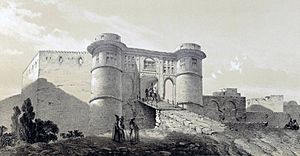Drawbridge facts for kids
A drawbridge is a special kind of bridge that can be moved. People use them to control who or what can cross. Long ago, they were a key part of medieval castles, often built over a moat (a deep ditch filled with water).
Today, you can find modern drawbridges over busy waterways. They lift up to let large ships pass by. Then, they lower down so cars, trucks, and pedestrians (people walking) can cross safely.
Drawbridges in Castles
Many medieval castles had a deep ditch or moat around them for defense. A wooden bridge usually crossed this moat. In the very early days, castles might destroy or remove their bridge if attacked. But soon, drawbridges became very common.
A typical castle drawbridge was right outside the main gatehouse. It had a wooden deck that was hinged at the gatehouse entrance. When raised, the bridge would stand straight up against the gate, making an extra barrier. This was often protected by strong metal gates called portcullises and other doors. Defenders could also shoot arrows or drop things from openings above (called machicolations) or from towers on the sides.
Castle workers would raise or lower the bridge using ropes or chains. These were connected to a machine called a windlass inside a room above the gate. Lifting a heavy bridge needed help, so most drawbridges used a "bascule" system. This means they had a counterweight to make them easier to move.
Sometimes, the bridge would extend inside the gate passage, past its pivot point. This inner part could swing into a pit, adding another obstacle for attackers. Other times, heavy beams acted as counterweights.
The chains that lifted the bridge could also be attached to counterweights. For example, at Alnwick Castle in England, a portcullis (a heavy gate) was used as the counterweight. By the 1300s, a system with lifting arms, called "gaffs," became common. These arms were above the bridge deck and connected to the lifting end of the bridge with chains. When the bridge was up, the gaffs would fit into special slots in the gatehouse wall. You can still see these slots at places like Herstmonceux Castle. Inside the castle, the gaffs had counterweights.
In France, some castles still have working drawbridges, like the Château du Plessis-Bourré. In England, two working drawbridges are still used regularly at Helmingham Hall, which was built in the early 1500s.
How a Turning Bridge Works
A "turning bridge" is a type of drawbridge that pivots on central pins called trunnions. It might or might not have the lifting chains you see on other drawbridges. The end of the bridge inside the castle had counterweights. This allowed it to sink into a pit in the gate passage. When the bridge was flat, strong pegs were often inserted through the side walls to support it. This design was a bit tricky, so many turning bridges were later replaced with more advanced drawbridges.
Images for kids
-
The Poortbrug in Leeuwarden, a double-beam drawbridge, crosses the old city moat.
See also
 In Spanish: Puente levadizo para niños
In Spanish: Puente levadizo para niños




